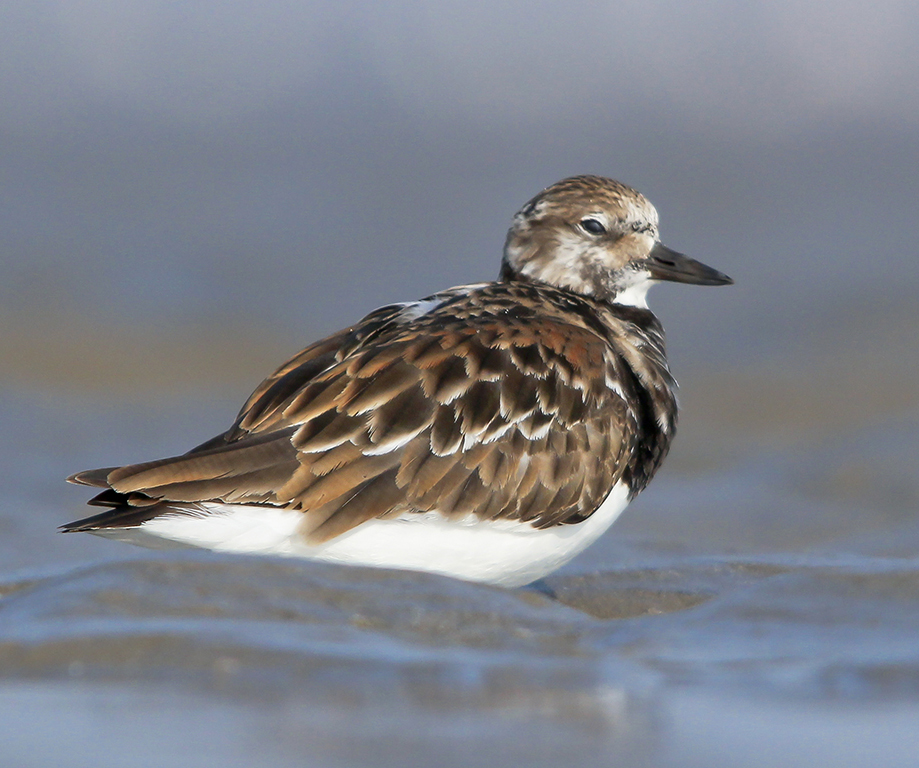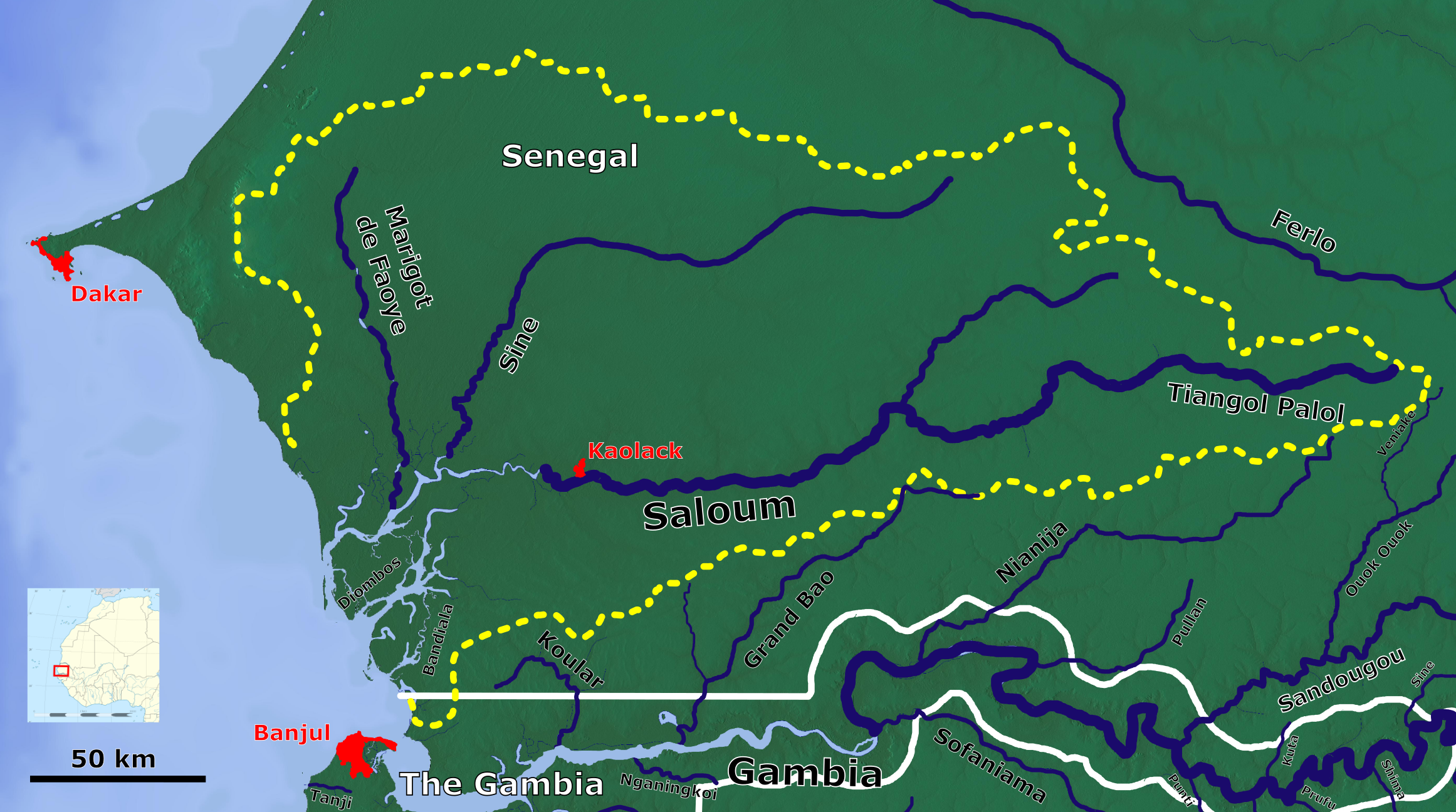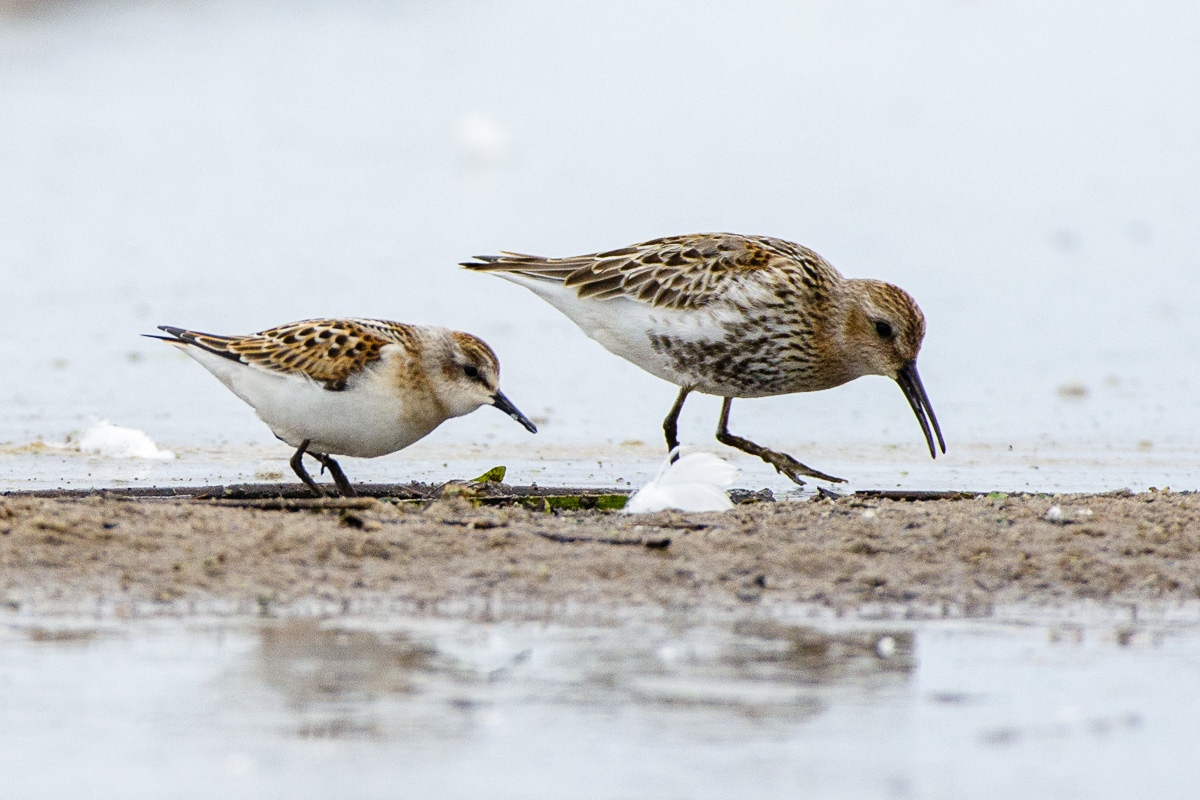|
Saloum Delta National Park
Saloum Delta National Park or Parc National du Delta du Saloum in Senegal, is a national park. Established in 1976, it is situated within the Saloum Delta at the juncture of the Saloum River and the North Atlantic. The park, which forms part of a UNESCO World Heritage Site and a Ramsar Convention site, lies within a biosphere reserve. Water comprises of the park, intertidal mangroves and saltwater vegetation cover , and savannah and forest cover . It lies on the East Atlantic Flyway. The bird species that breed or winter in the area include royal tern, greater flamingo, Eurasian spoonbill, curlew sandpiper, ruddy turnstone, and little stint. This region represents an important synergy between nature with extensive biodiversity and the way of human development, which is still present, albeit fragile. Sustainable shellfish farming is highly developed here and is a very important source of food and export revenue for the local community and Senegal in general. The Saloum Del ... [...More Info...] [...Related Items...] OR: [Wikipedia] [Google] [Baidu] |
Saloum Delta
Saloum Delta or Sine-Saloum Delta is a river delta in Senegal at the mouth of the Saloum River where it flows into the North Atlantic Ocean. The delta covers 180,000 hectares. It extends 72.5 kilometers along the coastline and 35 kilometers inland. In 2011, a 145,811-hectare portion of the delta was designated a UNESCO World Heritage site. The site contains "brackish channels encompassing over 200 islands and islets, mangrove forest, an Atlantic marine environment, and dry forest." Saloum Delta National Park covers 76,000 hectares of the delta. The bird species that breed or winter in the area include royal tern, greater flamingo, Eurasian spoonbill, curlew sandpiper, ruddy turnstone, and little stint The little stint (''Calidris minuta'' or ''Erolia minuta''), is a very small wader. It breeds in arctic Europe and Asia, and is a long-distance migrant, wintering south to Africa and south Asia. It occasionally is a vagrant to North America a .... Aside from being a valued br ... [...More Info...] [...Related Items...] OR: [Wikipedia] [Google] [Baidu] |
Ruddy Turnstone
The ruddy turnstone (''Arenaria interpres'') is a small cosmopolitan wading bird, one of two species of turnstone in the genus ''Arenaria''. It is now classified in the sandpiper family Scolopacidae but was formerly sometimes placed in the plover family Charadriidae. It is a highly migratory bird, breeding in northern parts of Eurasia and North America and flying south to winter on coastlines almost worldwide. It is the only species of turnstone in much of its range and is often known simply as turnstone. Taxonomy The ruddy turnstone was formally described by the Swedish naturalist Carl Linnaeus in 1758 in the tenth edition of his ''Systema Naturae'' under the binomial name ''Tringa interpres''. The species is now placed together with the black turnstone in the genus '' Arenaria'' that was introduced by the French zoologist Mathurin Jacques Brisson in 1760 with the ruddy turnstone as the type species. The genus name ''arenaria'' is from Latin ''arenarius'', "inhabiting sand" ... [...More Info...] [...Related Items...] OR: [Wikipedia] [Google] [Baidu] |
National Parks Of Senegal
National may refer to: Common uses * Nation or country ** Nationality – a ''national'' is a person who is subject to a nation, regardless of whether the person has full rights as a citizen Places in the United States * National, Maryland, census-designated place * National, Nevada, ghost town * National, Utah, ghost town * National, West Virginia, unincorporated community Commerce * National (brand), a brand name of electronic goods from Panasonic * National Benzole (or simply known as National), former petrol station chain in the UK, merged with BP * National Car Rental, an American rental car company * National Energy Systems, a former name of Eco Marine Power * National Entertainment Commission, a former name of the Media Rating Council * National Motor Vehicle Company, Indianapolis, Indiana, USA 1900-1924 * National Supermarkets, a defunct American grocery store chain * National String Instrument Corporation, a guitar company formed to manufacture the first resonator g ... [...More Info...] [...Related Items...] OR: [Wikipedia] [Google] [Baidu] |
Ramsar Sites In Senegal
Ramsar may refer to: * Places so named: ** Ramsar, Mazandaran, city in Iran ** Ramsar, Rajasthan, village in India * Eponyms of the Iranian city: ** Ramsar Convention concerning wetlands, signed in Ramsar, Iran ** Ramsar site, wetland listed in accord wth the Ramsar Convention * Others ** Ramsar Palace The Ramsar Palace or Marmar Palace is one of the historic buildings and royal residences in Iran. The palace is in Ramsar, a city on the coast of the Caspian Sea. History The Ramsar Palace was established on a land of 60,000 square meters in 19 ..., a palace in Ramsar, Mazandaran See also * :Ramsar sites {{Disambig, geo ... [...More Info...] [...Related Items...] OR: [Wikipedia] [Google] [Baidu] |
UNESCO
The United Nations Educational, Scientific and Cultural Organization is a specialized agency of the United Nations (UN) aimed at promoting world peace and security through international cooperation in education, arts, sciences and culture. It has 193 member states and 12 associate members, as well as partners in the non-governmental, intergovernmental and private sector. Headquartered at the World Heritage Centre in Paris, France, UNESCO has 53 regional field offices and 199 national commissions that facilitate its global mandate. UNESCO was founded in 1945 as the successor to the League of Nations's International Committee on Intellectual Cooperation.English summary). Its constitution establishes the agency's goals, governing structure, and operating framework. UNESCO's founding mission, which was shaped by the Second World War, is to advance peace, sustainable development and human rights by facilitating collaboration and dialogue among nations. It pursues this objectiv ... [...More Info...] [...Related Items...] OR: [Wikipedia] [Google] [Baidu] |
Birdlife International
BirdLife International is a global partnership of non-governmental organizations that strives to conserve birds and their habitats. BirdLife International's priorities include preventing extinction of bird species, identifying and safeguarding important sites for birds, maintaining and restoring key bird habitats, and empowering conservationists worldwide. It has a membership of more than 2.5 million people across 116 country partner organizations, including the Royal Society for the Protection of Birds, the Wild Bird Society of Japan, the National Audubon Society and American Bird Conservancy. BirdLife International has identified 13,000 Important Bird and Biodiversity Areas and is the official International Union for Conservation of Nature’s Red List authority for birds. As of 2015, BirdLife International has established that 1,375 bird species (13% of the total) are threatened with extinction ( critically endangered, endangered or vulnerable). BirdLife International ... [...More Info...] [...Related Items...] OR: [Wikipedia] [Google] [Baidu] |
Sine-Saloum
Sine-Saloum is a region in Senegal located north of the Gambia and south of the Petite Côte. It encompasses an area of 24,000 square kilometers, about 12% of Senegal, with a population in the 1990s of 1,060,000. The western portion contains the Saloum Delta, a river delta at the junction of the Saloum and the North Atlantic. It is in this region that the Saloum Delta National Park is located. 145,811 hectares of the Delta were designated a UNESCO Heritage Site in 2011. Because it flows so slowly, this delta allows saltwater to travel deep inland. Long ago, the Serer kingdoms of Sine and Saloum were rivals. In 1984, the area was divided into two administrative regions: Kaolack and Fatick. Regions of Senegal Economy Primary economic activities in the 2000s consisted of fishing, salt production, peanut farming, and millet farming. Transportation is difficult because of the many islands. A secondary economy is the construction of fishing boats. Ecosystem Much of the region ... [...More Info...] [...Related Items...] OR: [Wikipedia] [Google] [Baidu] |
Sine River
The River Sine or Sine River (Siin in Serer language) is a river in Senegal. It flows into the Atlantic Ocean with the River Saloum in the delta of Sine-Saloum. See also *Saloum Delta National Park, a UNESCO World Heritage site. * Saloum River *Sine-Saloum Sine-Saloum is a region in Senegal located north of the Gambia and south of the Petite Côte. It encompasses an area of 24,000 square kilometers, about 12% of Senegal, with a population in the 1990s of 1,060,000. The western portion contains the ... External links « Le pacte primordial dans la vallée du Sine »(articles n''Éthiopiques'' n° 31) Rivers of Senegal Serer holy places Serer country {{Senegal-river-stub ... [...More Info...] [...Related Items...] OR: [Wikipedia] [Google] [Baidu] |
Dakar
Dakar ( ; ; wo, Ndakaaru) (from :wo:daqaar, daqaar ''tamarind''), is the capital city, capital and List of cities in Senegal, largest city of Senegal. The city of Dakar proper has a population of 1,030,594, whereas the population of the Dakar metropolitan area is estimated at 3.94 million in 2021. The area around Dakar was settled in the 15th century. The Kingdom of Portugal, Portuguese established a presence on the island of Gorée off the coast of Cap-Vert and used it as a base for the Atlantic slave trade. Kingdom of France, France took over the island in 1677. Following the abolition of the slave trade and French annexation of the mainland area in the 19th century, Dakar grew into a major regional port and a major city of the French colonial empire. In 1902, Dakar replaced Saint-Louis, Senegal, Saint-Louis as the capital of French West Africa. From 1959 to 1960, Dakar was the capital of the short-lived Mali Federation. In 1960, it became the capital of the independent Repub ... [...More Info...] [...Related Items...] OR: [Wikipedia] [Google] [Baidu] |
Aquaculture
Aquaculture (less commonly spelled aquiculture), also known as aquafarming, is the controlled cultivation ("farming") of aquatic organisms such as fish, crustaceans, mollusks, algae and other organisms of value such as aquatic plants (e.g. lotus). Aquaculture involves cultivating freshwater, brackish water and saltwater populations under controlled or semi-natural conditions, and can be contrasted with commercial fishing, which is the harvesting of wild fish. Mariculture, commonly known as marine farming, refers specifically to aquaculture practiced in seawater habitats and lagoons, opposed to in freshwater aquaculture. Pisciculture is a type of aquaculture that consists of fish farming to obtain fish products as food. Aquaculture can also be defined as the breeding, growing, and harvesting of fish and other aquatic plants, also known as farming in water. It is an environmental source of food and commercial product which help to improve healthier habitats and used to re ... [...More Info...] [...Related Items...] OR: [Wikipedia] [Google] [Baidu] |
Little Stint
The little stint (''Calidris minuta'' or ''Erolia minuta''), is a very small wader. It breeds in arctic Europe and Asia, and is a long-distance migrant, wintering south to Africa and south Asia. It occasionally is a vagrant to North America and to Australia. The genus name is from Ancient Greek ''kalidris'' or ''skalidris'', a term used by Aristotle for some grey-coloured waterside birds. The specific ''minuta'' is Latin for "small. Description Its small size, fine dark bill, dark legs and quicker movements distinguish this species from all waders except the other dark-legged stints. It can be distinguished from these in all plumages by its combination of a fine bill tip, unwebbed toes and long primary projection. The call is a sharp "stit". The breeding adult has an orange wash to the breast, a white throat and a strong white V on its back. In winter plumage identification is difficult. Juveniles have pale crown stripes and a pinkish breast. An apparent hybrid between thi ... [...More Info...] [...Related Items...] OR: [Wikipedia] [Google] [Baidu] |
Curlew Sandpiper
The curlew sandpiper (''Calidris ferruginea'') is a small wader that breeds on the tundra of Arctic Siberia. It is strongly migratory, wintering mainly in Africa, but also in south and southeast Asia and in Australia and New Zealand. It is a vagrant to North America. Taxonomy The curlew sandpiper was formally described in 1763 by the Danish author Erik Pontoppidan under the binomial name ''Tringa ferrugineus''. It is now placed with 23 other sandpipers in the genus '' Calidris'' that was introduced in 1804 by the German naturalist Blasius Merrem. The genus name is from Ancient Greek ''kalidris'' or ''skalidris'', a term used by Aristotle for some grey-coloured waterside birds. The specific ''ferruginea'' is from Latin ''ferrugo, ferruginis'', "iron rust" referring to its colour in breeding plumage. The curlew sandpiper is treated as monotypic: no subspecies are recognised. Within the genus ''Calidris'' the curlew sandpiper is most closely related to the stilt sandpiper (''Cal ... [...More Info...] [...Related Items...] OR: [Wikipedia] [Google] [Baidu] |






